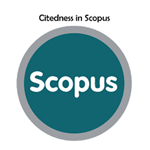Effect of HEC (Hydroxyethyl Cellulose) Polymer on Nanoemulsion-Based Curcumin Transdermal Patch Release
Abstract
Curcumin a hydrophobic polyphenolic compound and water-insoluble that creates low systemic bioavailability inside the body, has broad pharmacological activity, including anti-inflammation. This study aims to formulate, characterize and evaluate the nanoemulsion based on curcumin through an in vitro transdermal patch preparation. This study starts from formulating a curcumin nanoemulsion solution and characterizing the particle size of curcumin through PSA (Particle Size Analyzer). Further, it formulates the transdermal patch preparation with the smallest curcumin particles within three concentrations (HEC 0,625%, 1,25%, and 2,5%) combined with HPMC 2,5% as polymer. Those formulations are evaluated through organoleptic, thickness, weight uniformity, humidity, and folding resistance tests. In the next step, this study examines the penetration through an in vitro by using a franz diffusion cell within 72 hours. The result shows increasing penetration on each formula where the best penetrations occur in the 15th and 24th hours. It also discovers that the formula containing HEC 2,5% (2c) creates the highest cumulative drug penetration (15,83%). Therefore, it deduces that curcumin nanoemulsion in the transdermal patch has good characteristics and is compatible between drug and polymer.
Keywords
Full Text:
PDFReferences
M. Shahiduzzaman and A. Daugschies, "Curcumin: a natural herb extract with antiparasitic properties" Nature Helps..., pp. 141-152, 2011. http://dx.doi.org/10.1007/978-3-642-19382-8_6.
S. Peng, Z. Li, L. Zou, W. Liu, C. Liu, and D. J. McClements, "Enhancement of curcumin bioavailability by encapsulation in sophorolipid-coated nanoparticles: An in vitro and in vivo study" Journal of agricultural and food chemistry, vol. 66, no. 6, pp. 1488-1497, 2018. https://doi.org/10.1021/acs.jafc.7b05478.
P. Mishra, S. Mishra, and C. L. Mahanta, "Effect of maltodextrin concentration and inlet temperature during spray drying on physicochemical and antioxidant properties of amla (Emblica officinalis) juice powder" Food and Bioproducts Processing, vol. 92, no. 3, pp. 252-258, 2014. https://doi.org/10.1016/j.fbp.2013.08.003.
H. Tanwar and R. Sachdeva, "Transdermal drug delivery system: A review" International journal of pharmaceutical sciences and research, vol. 7, no. 6, p. 2274, 2016. https://doi.org/10.13040/IJPSR.0975-8232.7(6).2274-90.
R. C. Rowe, P. Sheskey, and M. Quinn, Handbook of pharmaceutical excipients. Libros Digitales-Pharmaceutical Press, 2009.
S. Cherukuri, U. R. Batchu, K. Mandava, V. Cherukuri, and K. R. Ganapuram, "Formulation and evaluation of transdermal drug delivery of topiramate" Int J Pharm Investig, vol. 7, no. 1, pp. 10-17, 2017, doi: 10.4103/jphi.JPHI_35_16. https://doi.org/10.4103/jphi.jphi_35_16.
"Development of Nitrendipine Transdermal Patches: In vitro and Ex ...: Ingenta Connect." https://www.ingentaconnect.com/content/ben/cdd/2007/00000004/00000001/art00008 (accessed Aug. 27, 2022).
P. K. Gupta, J. K. Pandit, A. Kumar, P. Swaroop, and S. Gupta, "Pharmaceutical nanotechnology novel nanoemulsion-high energy emulsification preparation, evaluation and application" The Pharma Research, vol. 3, no. 3, pp. 117-138, 2010.
M. Hosokawa, J. Nishino, and Y. Kanno, "Nanoparticle Technology Handbook 1st edition. UK: Elsevier Linacre House, Jordan Hill." Oxford OX2 8DP, 2007.
K. D. Puspitasari, D. Nurahmanto, and L. Ameliana, "Optimasi Hidroksipropil Metilselulosa dan Carbopol terhadap Moisture Content dan Laju Pelepasan Patch Ibuprofen In Vitro (Optimization of Hydroxypropyl Methylcellulose and Carbopol for Moisture Content and Release Rate of Ibuprofen Patch In Vitro)" Pustaka Kesehatan, vol. 4, no. 2, pp. 229-234, 2016.
K. Saroha, B. Yadav, and B. Sharma, "Transdermal patch: A discrete dosage form" Int J Curr Pharm Res, vol. 3, no. 3, pp. 98-108, 2011.
V. K. Wardani and D. Saryanti, "Formulasi Transdermal Patch Ekstrak Etanol Biji Pepaya (Carica papaya L.) dengan Basis Hydroxypropil Metilcellulose (HPMC)" Smart Medical Journal, vol. 4, no. 1, pp. 38-44. https://doi.org/10.13057/smj.v4i1.43613.
S. B. Shirsand, G. M. Ladhane, S. Prathap, and P. V. Prakash, "Design and evaluation of matrix transdermal patches of meloxicam" RGUHS J Pharm Sci, vol. 2, no. 4, pp. 58-65, 2012.
E. I. Setyawan, P. Y. A. Pratama, and D. K. Budiputra, "Optimasi Formula Matriks Patch Ketoprofen Transdermal Menggunakan Kombinasi Asam Oleat dan Minyak Atsiri Bunga Cempaka Putih (Michelia alba) sebagai Permeation Enhancer" Jurnal Farmasi Udayana, vol. 4, no. 2, p. 279799, 2015.
D. Nurahmanto, "Pengaruh Perbedaan Chemical Penetration Enhancer Pada Penetrasi Transdermal Patch Prometazin HCL" Jurnal Ilmiah Manuntung, vol. 2, no. 2, pp. 208-217, 2016. https://doi.org/10.51352/jim.v2i2.68.
M. S. Hasnain and A. K. Nayak, "21 - Chitosan as responsive polymer for drug delivery applications" in Stimuli Responsive Polymeric Nanocarriers for Drug Delivery Applications, Volume 1, A. S. H. Makhlouf and N. Y. Abu-Thabit, Eds. Woodhead Publishing, 2018, pp. 581-605. doi: 10.1016/B978-0-08-101997-9.00025-4.
L. Rathod, R. Kapadia, and K. Sawant, "A novel nanoparticles impregnated ocular insert for enhanced bioavailability to posterior segment of eye: In vitro, in vivo and stability studies" Materials Science and Engineering: C, vol. 71, Oct. 2016, doi: 10.1016/j.msec.2016.10.017.
N. Zakaria, "Formulasi Transdermal Patch Natrium Diklofenak sebagai Analgesik dan Antiinflamasi" 2020.
DOI: https://doi.org/10.37311/ijpe.v2i3.12025
Refbacks
- There are currently no refbacks.
Copyright (c) 2022 Rahmatia Is. Kaluku, Robert Tungadi, Nur Ain Thomas

Indonesian Journal of Pharmaceutical Education is licensed under a Creative Commons Attribution-NonCommercial-ShareAlike 4.0 International License.



